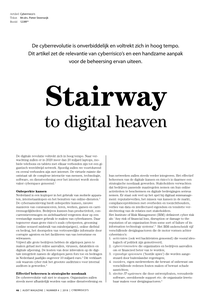DOCUMENT

De digitale revolutie voltrekt zich in hoog tempo. Naar verwachting zullen er in 2020 meer dan 20 miljard laptops, mobiele telefoons en tablets met elkaar verbonden zijn tot een gigantisch wereldwijd netwerk. Spoedig zullen we voortdurend en overal verbonden zijn met internet. De virtuele ruimte die ontstaat uit de complexe interactie van mensen, technologie, software, en dienstverlening over het internet wordt steeds vaker cyberspace genoemd
DOCUMENT

The use of mobile digital devices requires secure behaviour while using these devices. To influence this behaviour, one should be able to adequately measure the behaviour. The purpose of this study is to establish a model for measuring secure behaviour, and to use this model to measure the secure behaviour of individuals while using mobile digital devices such as smartphones and laptops.
DOCUMENT
During my first visit to Japan in 1990 I got acquainted with the Toshiba DynaBook. Unlike earlier laptops, this one was small, elegant and easily fitted into a backpack. A year later I was able to purchase one. This wonder of compact technology accompanied me during my travels to Berlin and Eastern Europe in the first part of the roaring 90s when I was writing for Mediamatic magazine. Our Agentur Bilwet (Adilkno) group composed The Media Archive and Datadandy books on this machine. The laptop assisted me in my move from Dutch to English as my main writing language. Even though it did not have a color screen, and ran MS-DOS (no Windows yet), I could pretty much do everything compared to what I do now. In 1992 a friend brought a new part over from Japan that could easily be installed next to the battery: the modem. From now on I was able to dial into bulletin boards. In 1993 I got access to the internet via hacktic, the forerunner of the xs4all provider. The rest is (my personal) internet history: The Digital City, desk.nl, nettime. The machine retired when I purchased an Acer in Taiwan, in 1999. No nostalgic feelings for a primitive technology. The Dynabook remains superior: a symbol of Japanese industrial supremacy, built before its downfall—in 1992.
MULTIFILE

Nu in het hoger onderwijs een generatie studenten rondloopt die gewend is om via smartphones en laptops informatie te vinden en te delen, lijkt het aanbieden van digitaal studiemateriaal logisch. Verschillende onderzoeken tonen echter aan dat dit niet helemaal aansluit op de behoeften van de hedendaagse student. Om lange, complexe teksten te bestuderen, prefereren studenten papier. De meest effectieve vorm lijkt te liggen in hybride studiemateriaal- een afgewogen combinatie van digitaal en papier -, zoals in de Bundle-pilot van het PublishingLab bij de Hogeschool van Amsterdam.
DOCUMENT

A comparative study of the effects of the pandemic across six countries, including The UK, Australia, Belgium, Cyprus, Ireland and The Netherlands. The authors outline 21 design principles for mobile learning, which is hoped will help us respond effectively in the uncertain present, and plan systematically for an unpredictable, post-pandemic future. This paper is based on the emergency changes we have had to make in the European DEIMP Project (2017-2020), “Designing and Evaluating Innovative Mobile Pedagogies” (DEIMP). DEIMP is undertaken by a transnational consortium comprising partner institutions and schools from the participating countries.
MULTIFILE

For IT services companies, delivering high quality IT services is of eminent importance. IT service quality drives customer satisfaction, which in its turn drives firm performance. It is this link that is addressed in this paper: How can the performance of customer service delivery teams be improved, when looked upon from the perspective of firm performance? Based on the literature on excellent performing organizations, we apply the concepts that, according to Collins (2001), drove the development of 'good' companies to 'great' companies to a case study of an under performing service delivery team that developed into an excellent performing service delivery team. The lessons from this study were that most of the drivers behind the performance improvement of this team were in fact 'soft' factors that concerned the human side of the team more than the organizational, procedural or structural measures.
DOCUMENT

Nowadays, digital tools for mathematics education are sophisticated and widely available. These tools offer important opportunities, but also come with constraints. Some tools are hard to tailor by teachers, educational designers and researchers; their functionality has to be taken for granted. Other tools offer many possible educational applications, which require didactical choices. In both cases, one may experience a tension between a teacher’s didactical goals and the tool’s affordances. From the perspective of Realistic Mathematics Education (RME), this challenge concerns both guided reinvention and didactical phenomenology. In this chapter, this dialectic relationship will be addressed through the description of two particular cases of using digital tools in Dutch mathematics education: the introduction of the graphing calculator (GC), and the evolution of the online Digital Mathematics Environment (DME). From these two case descriptions, my conclusion is that students need to develop new techniques for using digital tools; techniques that interact with conceptual understanding. For teachers, it is important to be able to tailor the digital tool to their didactical intentions. From the perspective of RME, I conclude that its match with using digital technology is not self-evident. Guided reinvention may be challenged by the rigid character of the tools, and the phenomena that form the point of departure of the learning of mathematics may change in a technology-rich classroom.
LINK